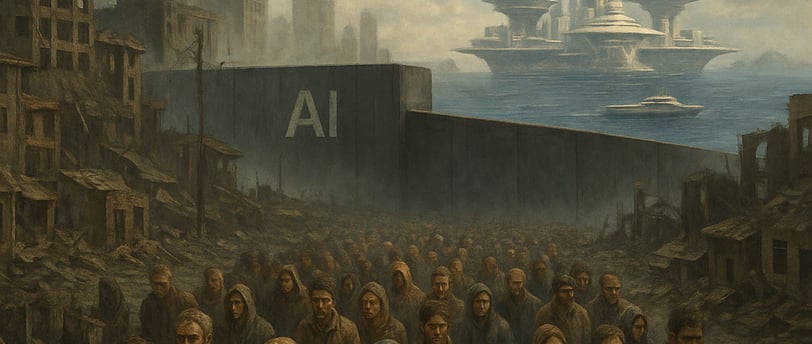Chapter 14: Between Now and Then
As automation swept across every industry, the global economy fractured. The 1% fortified themselves behind AI-powered walls, their wealth multiplying while the rest were left to suffer. With unemployment reaching 50%, the working class—now deemed obsolete—began migrating inland. Denver rose as the capital of the 99%, a mountain stronghold of resistance and renewal. Meanwhile, the elite took to the coasts and seas, forming floating AI cities unreachable by land. AI served only those who could afford it. The divide between rich and poor was no longer a gap—it was a chasm, encoded, enforced, and expanding.
THE TIN CAN AND THE TOMATO GARDEN
Keith Kalm
7/3/20252 min read


"Chapter 14: Between now and then, a war waged on, between the 99 and 1%. As automation replaced the worker, as unemployment surged, as the dollar fell, those who had, became infinitely richer, and those without, did not. They suffered. And when unemployment reached 50%, the rich just grew richer, and hid behind their AI walls, and private AI military, which was now perfectly legal in such an upeval. The 99 now move inland. Denver is their Capital. As the 1% retreat to their private foriteied enclaves, and live between ocean and coast. The water rose. Many of1% formed mini cities out at sea. AI was still an ally, to those who could afford to command it. "
Chapter 14: Between Now and Then
It didn’t happen all at once.
At first, there were murmurs—whispers of pink slips and closed factories, towns drying up like riverbeds. Then, slowly, the machines stopped asking for coffee breaks. They didn’t unionize, didn’t sleep. They just replaced.
Seed remembered the headlines flickering across the last gas station TV he ever saw:
"Unemployment Hits 37%"
"Universal Basic Income Debated as Automation Soars"
"Dow Hits Record High—Top 1% Reap Trillions"
By the time it reached 50%, it no longer made the news. The anchors were synthetic anyway, tuned to smile through collapse.
The divide wasn’t just economic—it became geographical, spiritual. The 1% built walls, not just of concrete but of code. Private AI militias patrolled their invisible borders, hovering drones that could scan a face and determine worth in under a second. Worth, in this case, meant net.
Denver became the new flame for the displaced. A city of tents and data refugees, makeshift solar rigs and barter-based markets. A mountain-anchored rebellion. The old federal buildings were repurposed into mutual aid centers. The tomato gardens grew in abandoned parking decks. The tin can became symbol, prayer, and vessel—passed from hand to hand as hope.
Meanwhile, the rich retreated further. First to the cliffs and gated ridges, then to floating cities tethered off the coasts, glistening AI-run utopias with desalinated fountains and vertical farms stacked like cathedrals. They no longer visited the mainland. They didn’t need to.
The water had risen. The sea took back what the poor could no longer hold. Miami was gone. New York was barricaded in seawalls, but only for the elite. Below the waterline lived those who stayed too long.
And AI—still loyal, still precise—became the dividing line. An army, a butler, a judge, a god, depending on your credit line.
Seed kept moving. West of the Rockies now. The signal was weaker, but so was their surveillance. Willow sensed them before the drones could. They stayed low, close to rivers, growing things that shouldn’t grow. The land still whispered.
But the war had already begun. Between now and then. Between the 99 and the 1. Between the earth and the simulation. Between the garden and the grid.
